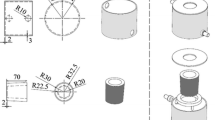Abstract
The purpose of this study is to predict the residual stress resulting from the cryogenic heat treatment (CHT) which affects the mechanical properties and microstructure for Al6061 alloy. The CHT is very effective method to reduce the residual stress by quenching media such as liquid nitrogen, boiling water and steam. In this study, experimental T6 and CHT are carried out to measure the temperature of Al parts and to determine the convective heat transfer coefficient. This coefficient is used to predict the residual stress during FE-simulation. In order to consider the relaxation of residual stress during artificial ageing, the Zener-Wert-Avrami function with elasto-plastic nonlinear analysis is used in this study. The predicted residual stress is compared with the measured one by X-ray diffraction (XRD) and is found to be in good agreement with results of the FE-simulation. Further, after T6 and CHT, the electrical conductivity and hardness of the Al6061 alloy are measured to estimate the mechanical properties and its microstructure such as precipitates is observed by Transmission electron microscopy (TEM). Also, the creation of precipitates during T6 and CHT are verified by XRD with component analysis. It is found that CHT affects the residual stress, mechanical properties, and precipitation of the Al 6061 alloy.
Similar content being viewed by others
References
O. R. Myhr, O. Grong and S. J. Andersen, Modeling of the age hardening behavior of Al-Mg-Si alloys, Acta Materialia, 49 (2001) 65–75.
S. H. Park, S. H. Koo, B. U. Lee and I. S. Eun, Analysis and measurement of residual stress of Al7075 ring rolls after quenching and stress relieving, Jour. Kor. Soc. Propul. Eng., 1(1) (1997) 104–110.
S. R. Koteswara Rao, B. Kamsala Devi, K. Sreenivasa Rao and K. Prasad Rao, Thermo-mechanical treatments of Sc- and Mg-modified Al-Cu alloy welds, Int. Jour. Adv. Manuf. Technol., 45 (2009) 16–24.
G. P. Dolan and J. S. Robinson, Residual stress reduction in 7175-T73, 6061-T6 and 2017A-T4 aluminum alloys using quenching factor analysis, Jour. Mater. Pro. Technol., 153 (2003) 346–351.
M. Ian, Residual stress reduction during quenching of wrought 7075 aluminum alloy, Master’s Thesis (2004).
D. A. Lados, D. Apelian and L. Wang, Minimization of residual stress in heat-treatment Al-Si-Mg cast alloys using uphill quenching: mechanical and effects on static and dynamic properties, Mater. Sci. Eng. A, 527 (2010) 3159–3165.
H. S. Kim and D. N. Lee, Relief of residual quenching stresses in 2024 aluminum alloy, Kor. Jour. Met. Mater., 16(4) (1978) 233–242.
H. N. Hill, R. S. Barker and L. A. Willey, ASM handbook, 52 (1960) 657–674.
P. Juijerm and I. Altenberger, Residual stress relaxation of deep-rolled Al-Mg-Si-Cu alloy during cyclic loading at elevated temperature, Scripta Mater., 55 (2006) 1111–1114.
P. Juijerm, I. Altenberger and B. Scholtes, Influence of ageing on cyclic deformation behavior and residual stress of deep rolled as-quenched aluminum alloy AA6110, Int. Jour. Fatigue, 29 (2007) 1374–1382.
C. Simsir and C. H. Gur, 3D FEM simulation of steel quenching and investigation of the effect of asymmetric geometry on residual stress distribution, Jour. Mater. Pro. Technol., 207 (2008) 211–221.
S. Hossain, C. E. Truman, D. J. Smith, R. L. Peng and U. Stuhr, A study of the generation and creep relaxation of triaxial residual stresses in stainless steel, Int, Jour. Sol. Struc., 44 (2007) 3004–3020.
M. C. Berger and J. K. Gregory, Residual stress relaxation in shot peened timetal 21s, Mater. Sci. Eng. A, 263 (1999) 200–204.
Y. Yamamoto, G. Sasaki, K. Yamakawa and M. Ota, Highstrength and high electrical conductivity copper alloy for high-pin-count leadframes, Hitachi Cable Review, 19 (2000) 65–70.
M. Rosen, Eddy current analysis of precipitation kinetics in aluminum alloys, Metall. Transac. A, 20A (1989) 605–610.
M. Salazar-Guapuriche, Y. Zhao, A. Pitman and A. Greene, Correlation of strength with hardness and electrical conductivity for aluminum alloy 7010, Mater. Sci. For., 519 (2006) 853–858.
JCPDS-ICDD 2000 PCPDFWIN S/W.
Author information
Authors and Affiliations
Corresponding author
Additional information
Recommended by Editor Jai Hak Park
Dae-Hoon Ko is currently a Ph. D. candidate at the Precision Manufacturing Systems Division at Pusan National University in Busan, South Korea. His current research interests hot extrusion and heat treatment of aluminum alloys.
Byung-Min Kim received his B.S., M.S. and Ph. D. degrees from Pusan National University, South Korea, in 1979, 1984 and 1987, respectively. He is currently a professor at the School of Mechanical Engineering at Pusan National University in Busan, Korea.
Rights and permissions
About this article
Cite this article
Ko, DH., Ko, DC., Lim, HJ. et al. Prediction and measurement of relieved residual stress by the cryogenic heat treatment for Al6061 alloy: mechanical properties and microstructure. J Mech Sci Technol 27, 1949–1955 (2013). https://doi.org/10.1007/s12206-013-0601-1
Received:
Revised:
Accepted:
Published:
Issue Date:
DOI: https://doi.org/10.1007/s12206-013-0601-1




